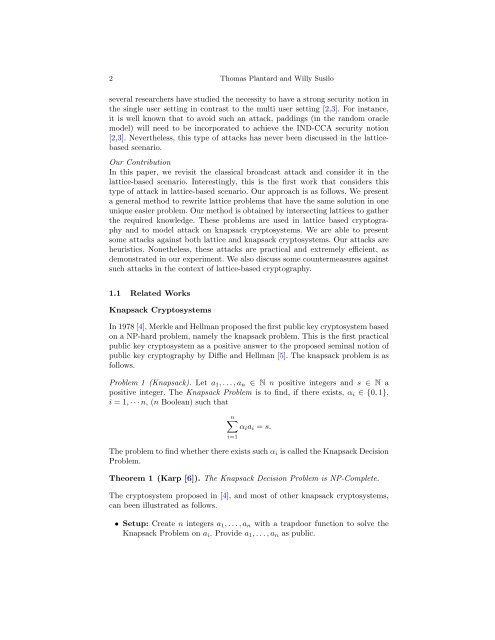Broadcast Attacks against Lattice-based Cryptosystems*
Broadcast Attacks against Lattice-based Cryptosystems*
Broadcast Attacks against Lattice-based Cryptosystems*
You also want an ePaper? Increase the reach of your titles
YUMPU automatically turns print PDFs into web optimized ePapers that Google loves.
2 Thomas Plantard and Willy Susiloseveral researchers have studied the necessity to have a strong security notion inthe single user setting in contrast to the multi user setting [2,3]. For instance,it is well known that to avoid such an attack, paddings (in the random oraclemodel) will need to be incorporated to achieve the IND-CCA security notion[2,3]. Nevertheless, this type of attacks has never been discussed in the lattice<strong>based</strong>scenario.Our ContributionIn this paper, we revisit the classical broadcast attack and consider it in thelattice-<strong>based</strong> scenario. Interestingly, this is the first work that considers thistype of attack in lattice-<strong>based</strong> scenario. Our approach is as follows. We presenta general method to rewrite lattice problems that have the same solution in oneunique easier problem. Our method is obtained by intersecting lattices to gatherthe required knowledge. These problems are used in lattice <strong>based</strong> cryptographyand to model attack on knapsack cryptosystems. We are able to presentsome attacks <strong>against</strong> both lattice and knapsack cryptosystems. Our attacks areheuristics. Nonetheless, these attacks are practical and extremely efficient, asdemonstrated in our experiment. We also discuss some countermeasures <strong>against</strong>such attacks in the context of lattice-<strong>based</strong> cryptography.1.1 Related WorksKnapsack CryptosystemsIn 1978 [4], Merkle and Hellman proposed the first public key cryptosystem <strong>based</strong>on a NP-hard problem, namely the knapsack problem. This is the first practicalpublic key cryptosystem as a positive answer to the proposed seminal notion ofpublic key cryptography by Diffie and Hellman [5]. The knapsack problem is asfollows.Problem 1 (Knapsack). Let a 1 , . . . , a n ∈ N n positive integers and s ∈ N apositive integer. The Knapsack Problem is to find, if there exists, α i ∈ {0, 1},i = 1, · · · n, (n Boolean) such thatn∑α i a i = s.i=1The problem to find whether there exists such α i is called the Knapsack DecisionProblem.Theorem 1 (Karp [6]). The Knapsack Decision Problem is NP-Complete.The cryptosystem proposed in [4], and most of other knapsack cryptosystems,can been illustrated as follows.• Setup: Create n integers a 1 , . . . , a n with a trapdoor function to solve theKnapsack Problem on a i . Provide a 1 , . . . , a n as public.
















